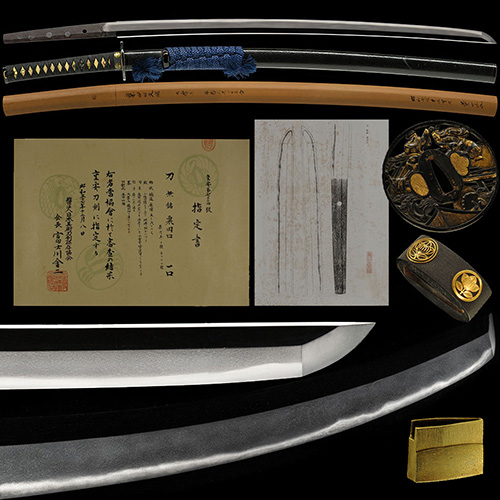
粟田口久国 刀 Awataguchi Hisakuni Katana
No.602361粟田口 久国 究極の梨子地肌に輝く沸がつき地刃明るく冴える格調高い名刀 二尺一寸六分 時代橘紋金具打刀拵付Awataguchi Hisakuni Ultimate Nashiji-hada Jiba with shining and clear Nie magnificent sword 65.4cm With period Tachibana crest metal fittings Koshirae
- 極めKiwame
- 粟田口Awataguchi
- 登録証Registration
- 静岡県 Shizuoka 昭和30年9月22日 9/22/30(Showa)
- 時代Period
- 鎌倉時代Kamakura era
- 法量Size
-
刃長 65.4cm (二尺一寸六分) 反り 1.2cm
元幅 2.9cm 先幅 2.0cm 元重 0.61cm 鎬厚 0.71cm 先重 0.47cm 鋒長 2.7cm 茎長 19.6cm 重量 658gHachou 65.4cm (二尺一寸六分) Sori 1.2cm
Moto-Haba 2.9cm Saki-Haba 2.0cm Moto-Kasane 0.61cm Shinogi-Thikess 0.71cm Saki-Kasane 0.47cm Kissaki-Chou 2.7cm Nakago-Chou 19.6cm Weight 658g - 国Country
- 山城Yamashiro
- 姿Shape
- 鎬造、庵棟、身幅広く、反りやや浅く、腰反りつき、中鋒。Shinogidukuri, Iorimune, Wide Mihaba, shallow Sori, Koshizori-tsuki, Chu-Kissaki
- 鍛Kitae
- 小板目肌つみ、板目肌に、小杢目肌交じり、地沸微塵に厚くつき、地景細かく入り、映り立ち、鉄明るく冴える。Small-Itamehada-tsumi, Itamehada ,Mixed Small-Mokumehada, Jinie entered fine and thickly, Chikei finely enters, Utsuritachi, Iron is bright and clear.
- 刃文Hamon
- 直刃調に、浅くのたれて、小乱れ交じり、二十刃掛り、足頻りに入り、小沸深くよくつき、金筋・砂流し掛り、匂深く、匂口明るく冴える。Suguha-style, Shallow-Notare, Mixed Small-Midare, Nijuba-kakari, Ashi entered finely. Small-Nie entered deeply , Kinsuji and Sunagashi-kakari, Deep Nioi, Nioikuchi is bright and clear.
- 帽子Boushi
- 沸深くつき、直ぐに丸く返る。Deep Nie-tsuki, Suguni-maruku-kaeru
- 茎Nakago
- 大磨上、先浅い栗尻、鑢目浅い勝手下り、目釘孔五内四埋。Oh-Suriage, Saki-asai-Kurijiri(Shallow Kurijiri), Shallow Yasurime-Kattesagari,Megugi holes are filled with five inner four.
- ハバキHabaki
- 金着二重Double gold
- 拵Sword mounitings
- 黒石目地塗鞘打刀拵[江戸時代]
説明
鐔 赤銅地金色絵。 縁 銘 大岡政寿 赤銅魚々子地橘紋金末紋。 目貫 赤銅地大黒図金色絵。宗典の赤銅鍔と縁には井伊家の丸に橘紋が入る優品。黒石目地塗鞘打刀拵[江戸時代]
説明
鐔 赤銅地金色絵。 縁 銘 大岡政寿 赤銅魚々子地橘紋金末紋。 目貫 赤銅地大黒図金色絵。宗典の赤銅鍔と縁には井伊家の丸に橘紋が入る優品。 - 説明Drscription
- 粟田口鍛冶は、国頼の子国家を祖とし、その子である国友・久国・国安・国清・有国・国綱の六人兄弟、国儔 の子則国。孫の国吉・国光、さらに国吉の子と伝える藤四郎吉光など、鎌倉時代初期から中期にかけ名工を輩出している。山城鍛冶の中でも、鍛えと匂口のよさに定評があり、品格高く技量が優れている。久国は、粟田口六兄弟の四番目で、名を四郎兵衛といい、重要文化財・重要美術品にも指定されている。この刀は、身幅尋常、反りやや浅く、腰反りつく優美な姿で、小板目肌に小杢目肌つみ、地沸が微塵に厚くつき、地景細かく入る所謂梨子地肌と呼称される明るく冴えた地鉄に映りが立ち、直刃調に、小足よく入り、小沸深くよくつき、金筋砂流し掛り、匂深く匂口明るく冴える。刃もたっぷり残り健全で、日本刀の中で最も精良と言われる梨子地肌と、足頻りに入る明るく冴えた匂口に、粟田口沸と呼ばれる輝く細かな沸、明るく輝く金筋が掛るなど豊かに働き、粟田口久国の見所を余すところなく示した格調高い名刀であるThe Awataguchi blacksmith was founded by Kuniyori's son Kuni, and his sons were six brothers: Kunitomo, Hisakuni, Kuniyasu, Kunikiyo, Arikuni, and Kunitsuna. Kuniyoshi and Kunimitsu, his grandsons, and Toshiro Yoshimitsu, who is said to be Kuniyoshi's son, produced master craftsmen from the early to the middle Kamakura period. Among Yamashiro blacksmiths, it has an established reputation for its forging and good smell, and is of high quality and excellent in skill. Hisakuni is the fourth of the Awataguchi Six Brothers, whose name is Shirobei, and is designated as Juyo Bunkazai, Juyo-Bijutsuhin.
This sword has a normal Mihaba, a slightly Shallow Sori, a graceful figure that Koshizori-tsuku , Small-Itamehada and Small-Mokume-hada, Jinie entered fine and thick, Chikei entered sincerely,A bright and clear Jigane called Nashiji-hada Utsuritatsu , Suguha-style, Small-Ashi entered well, Many Small-Nie-tsuki , Kinsuji and Sunagashi-kakari, Deep Nioi and Nioikuchi is bright and clear. Kenzen with plenty of blade left, Nashijihada, which is said to be the finest among Japanese swords, Ashi entered well and Nioikuchi is bright and clear ,Shining fine Nie called Awataguchi Nie, It works richly and brightly shining Kinsuji.It is a magnificent sword that fully shows the highlights of Awataguchi Hisakuni.



